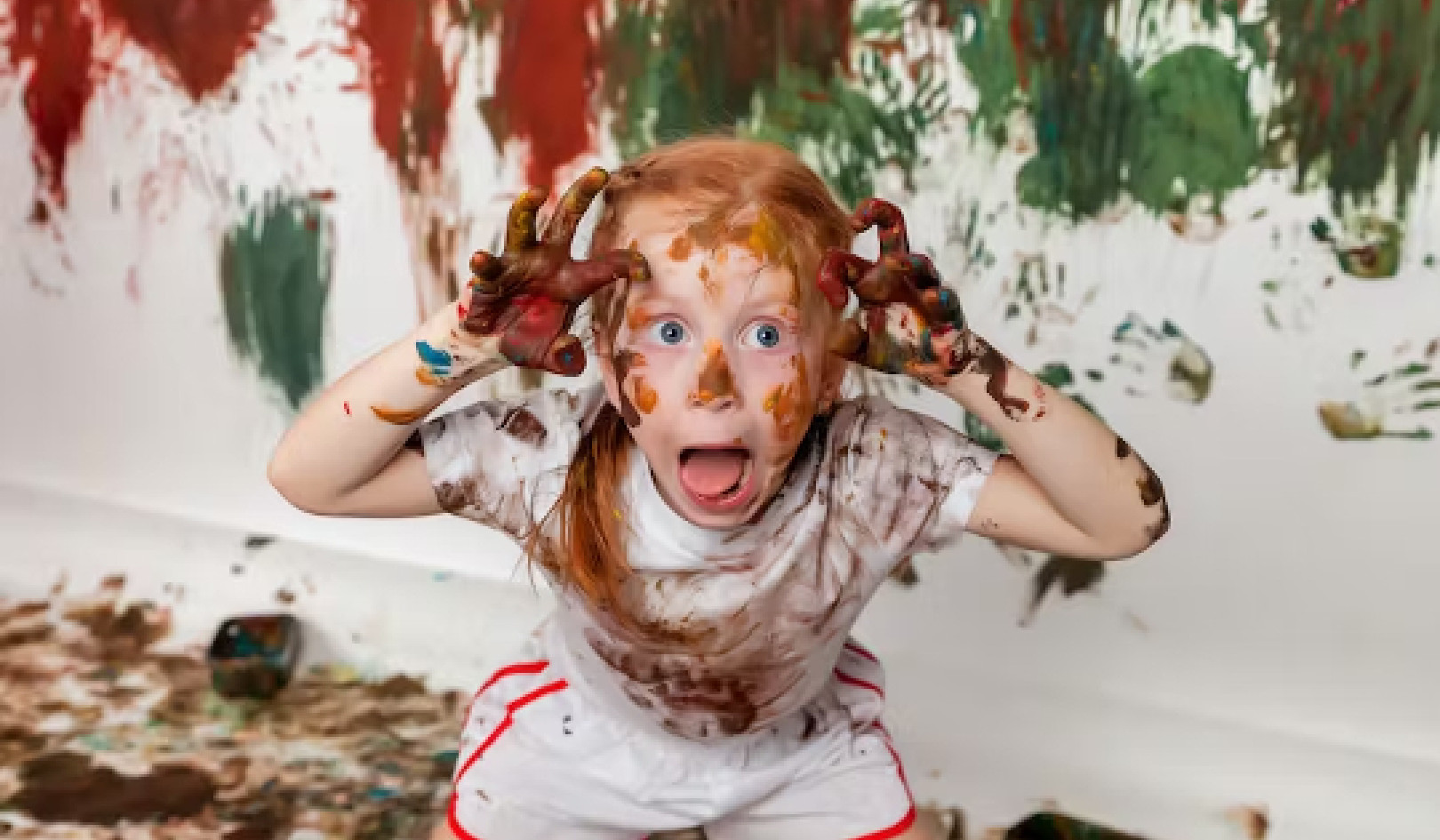
Image by Isabel Lewark
Narrated by Carmen Viktoria Gamper.
Editor's Note: While this article is written with children in mind, its precepts may be applied to "non-children" (a.k.a. adults) in "grown-up" situations.
Tension release is a significant part of self-healing in children and adults, and it is unavoidable when we become more present with ourselves in flow experiences. Children who go to a less than ideal school are in a daily reality that doesn’t respect their most pressing genuine developmental needs for movement, exploration, spontaneous play, and connection. Of course, this creates inner tension.
During the many school mornings of sitting, listening, and trying to focus, children increasingly lose touch with their genuine needs and curiosity. Their parents or significant caregivers are often the only ones they can turn to when they need support.
Having True Allies
Most of all, children need adults who are true allies, whom they can trust to love them exactly as they are. If they have this deep bond with at least one significant adult, parent, teacher, grandparent, or friend, children will develop a strong inner core and the skills to face all challenges.
Younger children naturally release tension during spontaneous play, self-talk, and time in nature. If your child still plays and talks during play—no matter how old they are—that’s a very good sign that their tension release mechanisms still work well.
Older children often stop playing and need different forms of tension release to express their frustration. Allow them to vent and complain, while you listen with patience and understanding. Computer games and other screen time aren’t ideal forms of tension release. Due to the screen’s addictive potential, and the passivity of the body during screen time, it may create more tension.
Stay with a child until they feel better. You can offer ways of tension release as described below.
Nine Ways To Help Your Child Release Tension
1. Allow children to cry.
Crying as part of feeling sad, disappointed, excluded, or treated unjustly is the most direct way to process uncomfortable experiences. Shedding tears is one of the most powerful ways of healing. Tears release emotional stress and physical toxins from the body.
Usually children feel completely renewed after a good cry, especially in the safe presence of an understanding adult. Sometimes children cry even when there is no apparent reason, or for seemingly unrelated reasons to be able to feel the relief of crying.
2. Allow children to laugh and laugh with children.
Children love to laugh. Uninhibited laughter is a joyful, effective way of tension release. When children laugh together with peers or adults, it is a powerful bonding experience, as long as all involved understand the reason for the laughter, and don’t feel insulted or hurt by it.
You may have noticed children have a different sense of humor than adults; nevertheless there are plenty of opportunities for children and adults to laugh together as long as the adult’s heart is open to the world of a child. For instance, adults may not find the repetition of the same knock-knock joke as funny as a seven-year-old, or they may not giggle as much about the poo-poo joke of a three-year-old. However, as adults, we can still open our hearts to a child’s light-hearted happiness and perceive it as what it is: an attempt to connect, release tension, and restore inner balance. Children’s laughter can be healing for both children and the adults around them.
3. Support children in resting.
Resting is a natural way of replenishing energies and releasing muscle tension after a period of intense physical movement or intellectually strenuous tasks. Let a child cuddle up in pillows or stretch and move on the floor as long as they want to, without any pressure to do anything. Children find their own perfect balance between activity and rest and naturally restore their energy when needed.
4. Offer places for pretend play.
Pretend and role-play are natural avenues for children to release tension.
5. Provide places for movement.
Most children are in constant movement. When they play a game on the floor, they stretch and frequently change position. When they sit at a table, they sway back and forth and move their legs. They are what adults sometimes call “fidgety.” All these movements release inner tension.
Allow children to move as much as they wish. Wherever possible, provide areas and safe opportunities for movement with hanging ropes, swings, climbing walls, boxing bags, jumping ropes, hula-hoops, and the like.
6. Help your child physically feel their emotion and let it go.
We can heal mind, body and heart by becoming deeply aware of our feelings and how they manifest in our bodies. When a child is upset, sad, or scared, you can try to lead them through a simple process.
Ask: “Where are you feeling this in your body? Is it in your throat, belly, or jaw? Point to where you are feeling this. Now, gently lay your hand on that place and let’s breathe deeply and feel this.” Then, see what happens. Often acknowledging a feeling is enough for a child to let it go.
7. Offer art supplies to draw, paint or craft.
Arts and crafts aren’t only for play and learning, but also for healing. Children release tension through creating something and tearing it up, drawing out scenes from their imagination, dreams, or memories, or painting on large surfaces with big brushes with the fulfilling attitude that it doesn’t matter if the painting can be displayed in the end.
You can lead your child to a tension release art project with questions such as “What would your feeling look like if it came through the door?” and “You could paint how you are feeling now, and then how you would like to feel.”
8. Let the child talk and simply listen.
As children get older (sometimes young children, too), they have increased verbal skills to reduce tension. Just like adults, children speak about challenges they face and just like adults, they are mostly not seeking answers or someone who solves their problem for them. Instead, they need someone to listen, someone who simply accepts and witnesses what they are going through.
Listen with your heart when a child speaks and detect their genuine needs behind their words. Empathize honestly, “I’m sorry you have to go through this, and I’m here for you through all of it.”
9. Allow screaming where it’s appropriate.
Screaming is another effective way of tension release. Think of places where it would be okay for your child to scream. Perhaps at the beach or in nature with not many people around. They might scream into pillows to dampen the sound.
A friend allows her child to yell all the four-letter-words she isn’t supposed to say into the pillows, so they don’t “get stuck inside.”
TRY THIS: Temper your child’s negative school experiences
Here are a few ways you can stand up for your child’s rights in standardized school:
— Opt your child out of state testing.
— Help teachers understand your child.
— Kindly ask teachers to reduce or stop your child’s homework.
— Request that your child may go to the restroom according to their needs.
— Request that your child be able to drink water anytime they are thirsty.
More ways to support your child’s school experience:
* On the evenings together and on days off, give your child a voice in decisions that affect them: let them choose their clothes, food (from only healthy choices), and room arrangements.
* Reduce or eliminate unnecessary appointments.
* To avoid rushing, ensure the whole family gets up early enough to allow ample time for getting ready for school.
* * * * *
All these tips and suggestions will help you and your child make the best of a less than ideal school situation. Your genuine support and understanding will make sure your child stays mentally healthy and learns that he or she can overcome any challenges, and that he or she is a valuable young person.
Copyright 2020 by Carmen Viktoria Gamper. All Rights Reserved.
Reprinted with permission: New Learning Culture Publishing
Article Source
Flow To Learn: A 52-Week Parent's Guide to Recognize & Support Your Child's Flow State - the Optimal Condition for Learning
by Carmen Viktoria Gamper
 Flow To Learn an uplifting, illustrated parent's guide offering 52 weeks filled with practical suggestions and compassionate insights to help your child through the ups and downs of childhood.
Flow To Learn an uplifting, illustrated parent's guide offering 52 weeks filled with practical suggestions and compassionate insights to help your child through the ups and downs of childhood.
Using practical, evidence-based tools from the fields of child development, psychology, and child-centered education, parents are guided step-by-step through the creation of simple hands-on activity stations that boost children's love for learning.
For more info and/or to order this book, click here.
About the Author
 Carmen Viktoria Gamper has worked internationally as an educator, advisor, coach and speaker for child-centered education. As founder of the New Learning Culture program, she supports parents, homeschooling families and schools in safely offering child-directed, flow-rich learning environments.
Carmen Viktoria Gamper has worked internationally as an educator, advisor, coach and speaker for child-centered education. As founder of the New Learning Culture program, she supports parents, homeschooling families and schools in safely offering child-directed, flow-rich learning environments.
She is the author of: Flow to Learn: A 52 Week Parent's Guide to Recognize and Support Your Child's Flow State - the Optimal Condition for Learning (New Learning Culture Publishing, March 27, 2020). Learn more at flowtolearn.com.




























